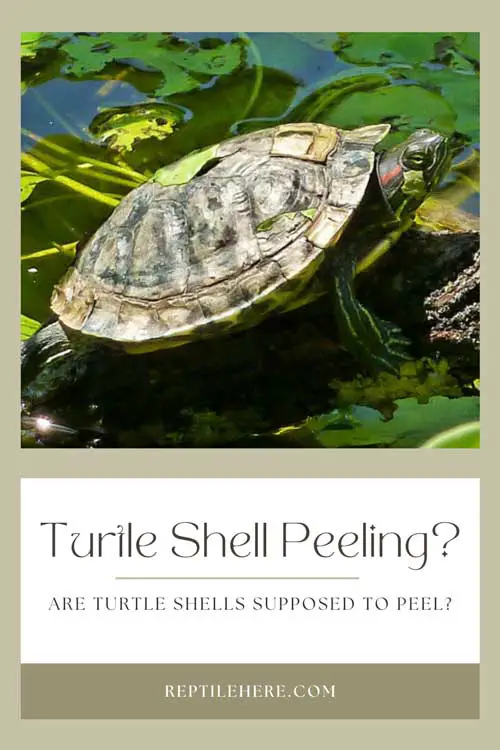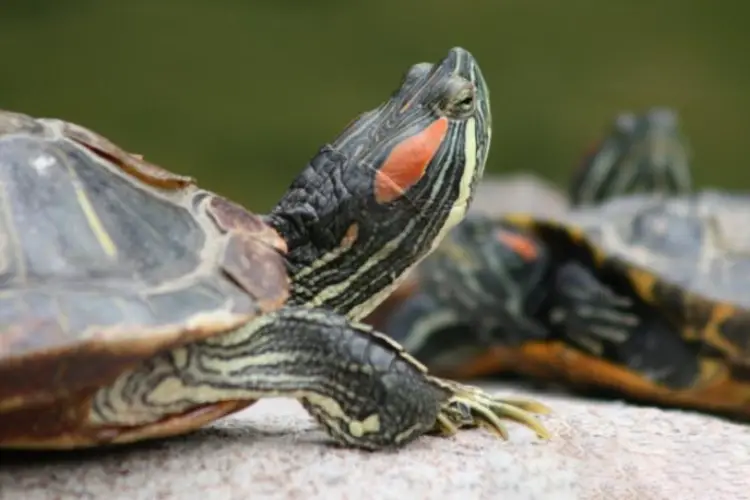Turtle Shell Peeling: Are Turtle Shells Supposed To Peel?
Have you lately noticed your pet turtle shell peeling? Has this made you worried as to what could be wrong with your turtle and wondered whether it could be a sign of an underlying issue with your pet? If yes, this guide will help you out.
Are turtle shells supposed to peel? Yes, turtle shell peeling is normal as the young turtle becomes older and mature adults, the shell grows with them, causing the scutes and outer layer to peel off in a thin layer. Peeling in turtles is a healthy part of animal growth.
However, there are times when turtle shell peeling might be unhealthy. The following post gives you more information on what healthy peeling is like in your pet turtle, what exactly to expect, and more.
Is Turtle Shell shedding normal?
Contents
Shedding in turtles is completely normal and nothing to be worried about. It is a normal and healthy part of their growth process and usually occurs in older adult turtles. Wild turtles go through this stage as well. In the growth process, the shell expands with the rest of the body, hence the need to shed the old scutes.
That said, not all shedding is normal. Sometimes your turtle may shed due to poor nutrition, environmental issues, algae, bacteria, or parasitic infections. (Source).
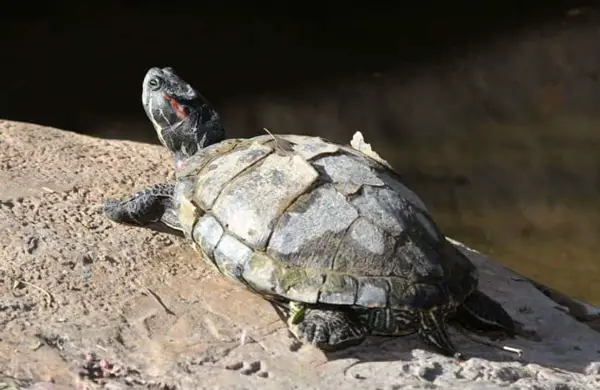
Any shedding caused by anything other than natural growth is referred to as unhealthy shedding. And knowing how to distinguish it from natural peeling is crucial to keeping your pet’s health in check.
The common species of aquatic turtles that shed their shells include Diamondback Terrapins, red-eared sliders, yellow belly sliders, map turtles, and painted turtles of various subspecies (including midland, eastern, southern, etc.).
Some of these species will even shed more easily than others. This is because their shells are growing constantly as they continue feeding, so they tend to shed more or less, depending on how fast they grow.
A perfect example is the sliders and painted species which tend to shed fairly regularly after they hit approx. 4 inches (the size for sexual maturity).
What is healthy shell peeling in your turtle?
Healthy shedding is where the turtle’s scutes naturally peel off as part of their growth. But you want to look for more details to ensure the shedding process your turtle is undergoing is normal and healthy.
When a turtle is shedding healthily, the scutes should come off in one piece and slowly. If you notice them coming off in chips and bits, then it could be a sign of a disease.
Sometimes small rocks can easily damage your turtle’s scutes or cause it to shed, so you may want to ensure the environment your pet turtle lives in is safe for them.
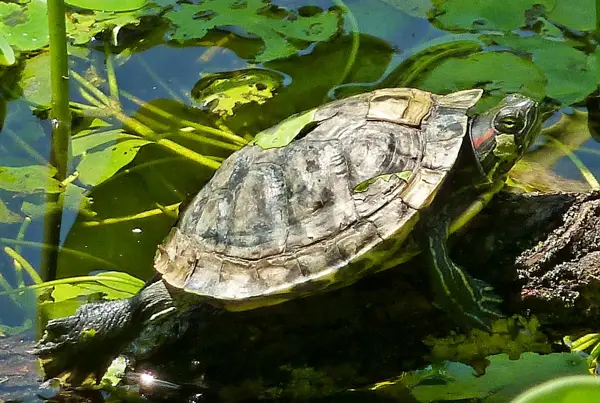
The pieces should also not appear too thick. In other words, they should look translucence if you were to hold them up to the light.
Keep in mind that water turtles have a tendency of eating some of their scutes after they peel.
For this reason, we advise you to get them off the tank as soon as they’re dropped since they could easily damage your pet’s throat and even the internal organs.
What does unhealthy turtle shell shedding look like?
Not all shedding in turtles is healthy. The easiest way to tell if shedding is unhealthy is by inspecting the turtle shell underneath.
Does it look reddened, whitish, deformed, or bloody under the scutes? or does it show exposed bone? Does it feel spongy or soft?
If you notice any of these signs in the underlying shell, it simply indicates a problem with your turtle and we advise you to seek veterinary advice ASAP.
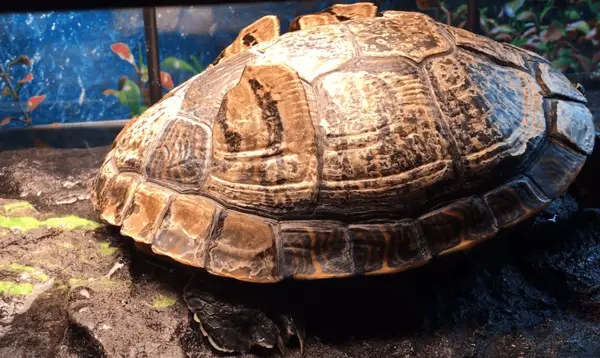
In case your turtle is shedding but those scutes don’t come off completely, you’ll also need to visit the exotic vet.
You shouldn’t ignore Dysecdysis (abnormal shedding) in your turtle as this can leave your pet’s shell highly exposed and vulnerable to a myriad of bacterial or fungal infections.
It may also indicate bone, thyroid, kidney, or liver disease. or it could be a sign of nutritional disease.
What causes unhealthy shedding in turtles?
We have just mentioned that an underlying condition or poor nutrition could be the reason behind unhealthy peeling. But there are also additional causes you need to know about as a turtle owner.
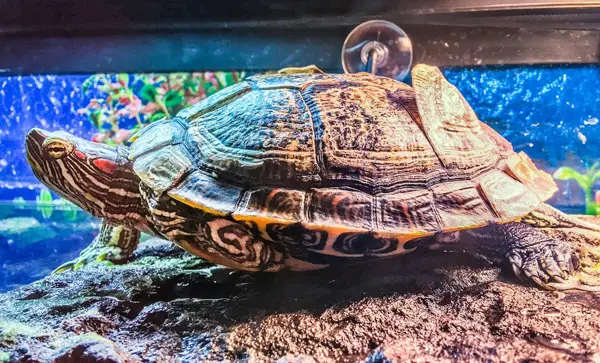
The main reasons why your turtle could be peeling unhealthily include:
- Bacterial shell rot can also be behind the abnormal peeling. This is a serious issue that could lead to permanent shell deformity in your lovely pet.
- Rapid growth-cased by overfeeding, causing the scutes to shed at a faster rate than normal. Overfeeding could also be the cause of other health issues in your turtle.
- High ammonia levels in the turtle tank can also cause abnormal shedding. Having a good filter with biological filtration can help prevent this issue.
- Injuries resulting from sharp rocks and other similar aspects in your turtle’s environment could also trigger unhealthy shedding. get rid of any sharp rocks in the tank that pose a danger to your pet.
- High temperatures or basking in too hot areas. Simply maintain the ideal temperature in your turtle tank to prevent hot spots that can easily injure your pet.
- Irritation/infection (both bacterial and fungal) can cause your turtle’s shell to shed unnaturally.
NOTE: If your pet’s condition is mild, you can easily handle it by making the necessary changes to your pet’s environment (discussed in our next section).
But if the condition is severe, we strongly recommend vising the vet instead of trying to treat your turtle’s abnormal peeling on your own.
Letting the expert handle it may also help in diagnosing any underlying medical issues and prescribing the best medication.
How to prevent unhealthy shell peeling in turtles?
You can prevent unhealthy shedding by maintaining a healthy environment for your turtle and visiting your vet as soon as your pet displays any health issues.
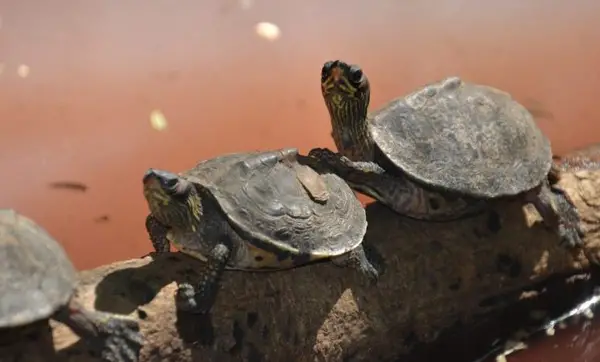
Here are some TIPS to keep your turtle safe from shell rot:
- Remove all sharp edges and objects, including rocks, in the turtle tank than can injure your turtle friend
- Dont put your pet in a tank with dirty water. Keep the water inside the tank clean at all times. Cleaning a third of this water weekly is recommended. Investing in a powerful filter will also help.
- Avoid making the water temperature too high that your turtle refuses to leave it to bask. Adjust the water heater to bring the temperatures low.
- Ensure your turtle’s basking dock is warm enough to help him/her adequately dry off. But don’t their environmental temperatures get too high!
- Ensure your turtle gets exposed to adequate UV light amounts to help with Vitamin D3 production
- Feed your turtle the correct diet to avoid the health consequences of improper diet.
How to differentiate between shell rot and shedding?
It is easy for new turtle owners to confuse shell rotting for shedding (and vice versa). However, the two are totally different things and you need to tell them apart so you can give your pet medical attention in case it is suffering from shell rot.
Closely look at the turtle’s shell damage: If the plates appear lifted and a foul-smelling discharge is coming under the shell, that’s shell rot! A white spot can also occur on the scute(s) affected by shell rot. When the rot gets worse, these scutes may even start falling off.
Shell rot is usually caused by a fungal or bacterial infection and is more common in aquatic turtles. This is because they spend most of their time in a humid environment which is ideal for fungus and bacterial growth.
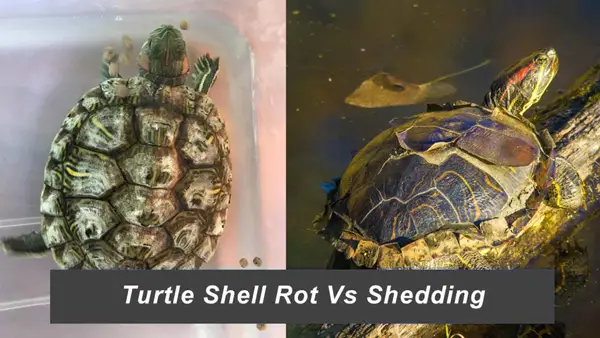
Turtle shell rot may occur if your pet suffers a crack, puncture, or scratch which is then left untreated. Note that it can also be transmitted from one turtle to the other, so it should be treated as soon as it’s possible.
Can you fix shell rot in turtles at home?
Absolutely! You can fix shell rot in your pet turtle at home by following the debriding procedure outlined below:
Step 1. Use a soft toothbrush to get rid of dirt and algae on your pet’s shell
Step 2. Gently scrape off any dirt and algae that ails to come off easily in the previous step
Step 3. Now apply an antiseptic (e.g. Nolvasan or silver sulfadiazine cream) to the rot
Step 4. Put your turtle in a warm and dry container for days during the treatment process. make sure they have access to a small water bowl for drinking.
Step 5. Repeat this treatment for one week. Depending on your specific turtle’s condition, you might want to do it for a few weeks.
If the problem doesn’t seem to go away after several debriding and antiseptic application sessions, it’s time to book an appointment with your vet!
After your turtle shows signs of healing, don’t forget to implement the simple tips in maintaining a good environment for your turtle before putting it back in the tank. These will go a long way in preventing shell rot in the future.
Watch the video below for more info on how to fix a shell rot at home
What if your turtle’s scutes aren’t peeling?
As a turtle owner, you may feel tempted to assist your beloved pet by removing those loose shell flaps. But we DON’T recommend this.
NEVER peel off the scutes or pick at them! Just let them fall off at their own pace. If you force off the scutes, you’ll simply be interfering with the natural growth and shedding process for your slider and unknowingly causing them to shed unhealthily.
Also, forcing off the loose flaps will damage the shell underneath, so just let nature takes its natural cause.
Note that after the shell is peeled off, you may notice your turtle trying to eat. This doesn’t mean your turtle is sick and is another natural thing for them to do. But we advise taking out peel from the tank to keep them from eating it as it can easily hurt their throats and internal organs.
The shell can also get caught up in the filter and easily break it, so you should ensure you get rid of it.
Related questions:
How often the turtle shedding of scutes occurs depends on their age and species. The shells of these animals expand as they grow, and become older and mature adults. So they’ll shed scute more or less often depending on how rapidly they grow. Some turtle species shed more readily than others while other species don’t shed at all.
You can tell if your turtle is about to shed if you notice them rubbing their scutes against the tank walls or the decorative items inside the tank. They may also start basking more to help them absorb UVB rays that help keep their shells healthy for extended periods of time. In some species, the shell color and texture may also change as the turtle is about to shed.
Final Word
Shell peeling is a perfectly natural process for turtles and should be nothing to worry you. But remember that the peeling process can be healthy or unhealthy.
Healthy shedding should reveal an underlying layer or new shell that feels and looks normal.
Otherwise, if you notice a spongy/soft-feeling shell or one that looks deformed, reddened, with white spots, etc., it indicates unhealthy shedding. Exposed bones also indicate unhealthy shedding.
We hope that this guide has helped you understand shell peeling in turtles and easily distinguish between a healthy and an unhealthy peeling process.
